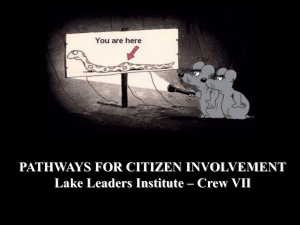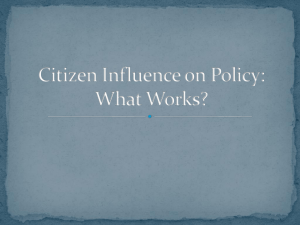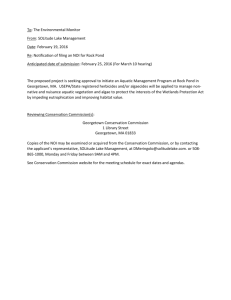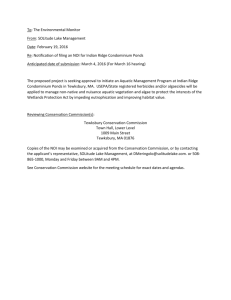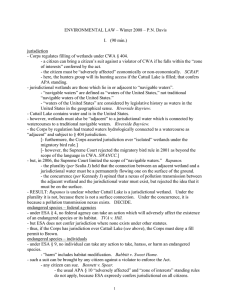PUBLIC POLICY, CITIZEN INVOLVEMENT & ADVOCACY Lake Leaders Institute – Crew VIII
advertisement
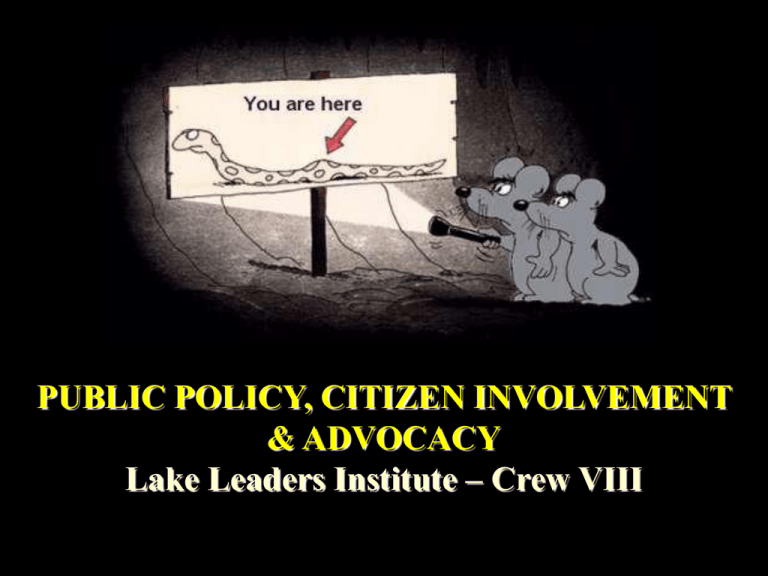
PUBLIC POLICY, CITIZEN INVOLVEMENT & ADVOCACY Lake Leaders Institute – Crew VIII Civics 101 Three Branches of Government: Legislative Sets broad policy objectives and establishes the general structures and regulations for carrying them out. Creates and passes a budget Executive Supervises the day-to-day administration of the programs and policies. Proposes a budget. Judicial Responsible for adjudicating any conflicts that may arise from the interpretation or application of the laws. Separation of powers among the three branches State Levels of Policy Laws (Statutes) are introduced and enacted by the state legislature and ratified by the Governor. Rules (Wis. Admin. Code) are introduced by the agency, enacted by the DNR Board, and ratified by the state legislature. Policy (Manual Code or Handbook) is introduced by the agency and enacted by the Secretary. Internal operating procedures. Interpretations (Regulation Pamphlets) written by the Dept. to disseminate regulations to the general public Laws are like sausages, it is better not to see them being made -- Otto von Bismarck Pretty or not, effective citizen advocates need to understand how laws that protect our water resources are made and implemented. Legislation: There ought to be a law! • • • • • • • • • Bill drafted Bill introduced—Author, co authors, sponsors Assigned to Committee Public Hearing Amendments Debate & vote by full House Repeat in other House Possible joint committee to iron out differences Governor – sign or veto Implementation Did Legislation grant ―rule making authority‖? If so, an agency of the Executive Branch is responsible for generating an ―Administrative Rule‖ that specifies and regulates the implementation of the law. Agencies have general rulemaking authority too. Why are Administrative Rules needed? Most often, the Legislature does not include all the details and specifics in the Law but rather only includes the intent of the law in general terms. Administrative Rules provide the details and specifics needed for the implementation of the Law. Once an Administrative Rule is ―promulgated‖ it carries the full force of Law. Example: 281.31 Navigable waters protection law. (1) To aid in the fulfillment of the state’s role as trustee of its navigable waters and to promote public health, safety, convenience and general welfare, it is declared to be in the public interest to make studies, establish policies, make plans and authorize municipal shoreland zoning regulations for the efficient use, conservation, development and protection of this state’s water resources. The regulations shall relate to lands under, abutting or lying close to navigable waters. The purposes of the regulations shall be to further the maintenance of safe and healthful conditions; prevent and control water pollution; protect spawning grounds, fish and aquatic life; control building sites, placement of structure and land uses and reserve shore cover and natural beauty. 59.692 Zoning of shorelands on navigable waters. (1) In this section:….(b) ―Shorelands‖ means the area within the following distances from the ordinary high−water mark of navigable waters, as defined under s. 281.31 (2) (d): 1. One thousand feet from a lake, pond or flowage. If the navigable water is a glacial pothole lake, this distance shall be measured from the high−water mark of the lake. 2. Three hundred feet from a river or stream or to the landward side of the floodplain, whichever distance is greater. Administrative Rule Development Process 1 2 3 Legislation directs rule-making or may consider recommendations from the Natural Resources Board, Conservation Congress, anglers, and other groups under general rule making authority. Staff prepares proposals for review and approval for public hearings by the NRB. Process may include advisory committees. Department conducts public hearings to receive input. Spring Hearings/Conservation Congress Meetings annually address fish and game regulations. Regulation Process (continued) 4 5 Input from Hearings reviewed, proposals may be modified to address feedback and forwarded to the NRB for approval (green sheet process). Conservation Congress proposals must receive majority support to move forward. Following NRB approval, rules are forwarded to the Legislature standing committees for review and hearings. No action = new rule. Remand, suspend but not modify. EMERGENCY ORDER Pathways for DNR Rule Changes Interested Public Staff Cons. Congress DNR Admin. Natural Resources Board Public Hearings Legislature Natural Resources Board Jonathan P. Ela, Chair – Madison: Conservationist, retired from the Sierra Club John W. Welter, Vice Chair - Eau Claire: Attorney David Clausen, Secretary – Amery: Veterinarian Preston D. Cole – Milwaukee: Environmental Services Superintendent, Public Works Gary E. Rohde - River Falls: Former Sec. of DATCP Christine L. Thomas, - Stevens Point: Dean & professor at the UWSP Jane Wiley – Wausau: Community conservation activist Committees Air, Waste, Water Management & Enforcement - Clausen Land Management, Recreation, Fish &Wildlife - Welter Lakes & AIS Funding $ 1,900,000 - Lake Operations Base * $ 300,000 - EPA s. 319 Grant $ 100,000 - Aquatic Plant Management Fees $ 500,000 - Lake Planning Grants* $ 1,700,000 - Lake Protection Grants* $ 212,000 - Citizen Lake Monitoring Contracts* $ 225,000 - Lake Classification Contracts* $ 4,757,000 $ 529,000 - Aquatic Invasives Operations Base* $ 3,700,000 - Aquatic Invasives Species Grants* $ 255,000 - AIS Technical Assistance Contracts* $ 2,400,000 - Great Lakes Restoration Initiative Grants $ 6,884,000 * Water Resources Account $ 11,641,000 CONSERVATION CONGRESS COMMITTEES • • • • • • • • • • Air, Waste & Water Awards Bear Big Game CWD Endangered Resources & Law Enforcement Forestry, Parks & Recreation Fur Harvest Great Lakes Hunting with Dogs • • • • • • • • • • Legislative Migratory Mississippi River Outdoor Heritage & Education Public & Private Land Use Rules & Resolutions Trout Turkey Upland game Warm Water Habitat Local Levels of Policy Ordinances (County/Municipal) introduced by standing committee, departments or elected officials and approved by the full board. Sometimes a state mandate. Handbooks or Manual Codes and Interpretations too. Plans – Comprehensive, Land & Water Zoning Committee and Board of Adjustment * NR 115 Land & Water Conservation Committee THE END? CONGRATULATIONS!
